BUSN20017: Effective Business Communication - Project Management
VerifiedAdded on 2022/10/11
|8
|2482
|18
Essay
AI Summary
This essay, written for BUSN20017: Effective Business Communication, addresses the challenges faced by a country manager who has hired ten new overseas employees arriving in Australia. The essay explores the business communication practices prevalent in Australian workplaces to help these new employees integrate successfully. It reviews various academic articles to identify effective communication strategies and provides recommendations for both competent and incompetent behaviors in the Australian work environment. The literature review examines studies by Macnamara, Wiewiora et al., Love and Singh, Ballantyne et al., Hossain, Nettle et al., Hogarth et al., Shaker, Marshalsey and Sclater, and Buhmann et al. These studies analyze topics such as the use of new media, public relations, social media strategies, workplace branding, reciprocal value propositions, onboarding processes, feedback mechanisms, reputation management, and communication strategies for diverse employees. The essay also references Alteren and Tudoran, Gallois and Giles, Dolan et al., and Murray et al. to provide specific guidance on communication styles, including tone of voice, use of language, and nonverbal cues. The goal is to help the new employees understand and adapt to the Australian workplace culture to ensure effective communication and integration.
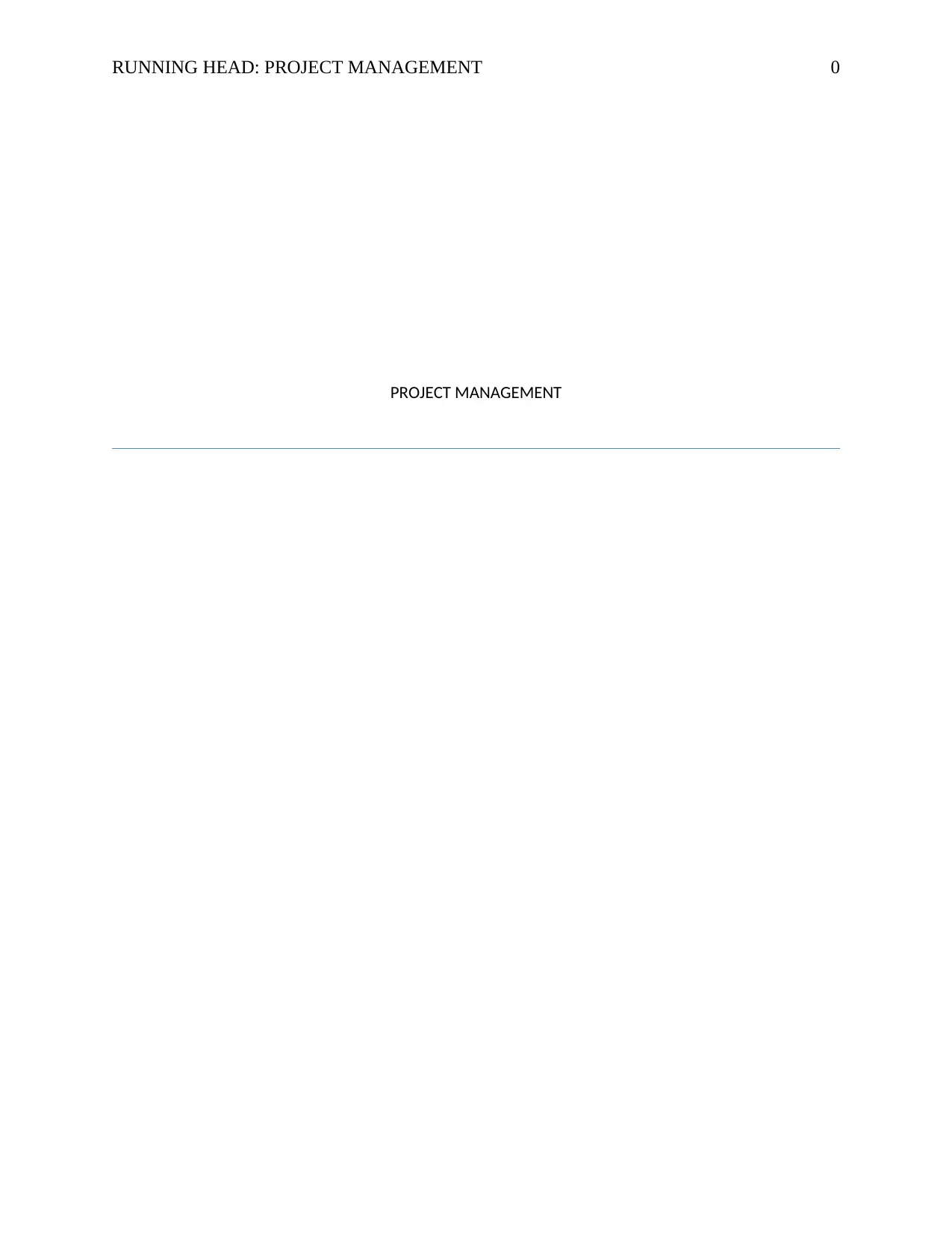
RUNNING HEAD: PROJECT MANAGEMENT 0
PROJECT MANAGEMENT
PROJECT MANAGEMENT
Paraphrase This Document
Need a fresh take? Get an instant paraphrase of this document with our AI Paraphraser
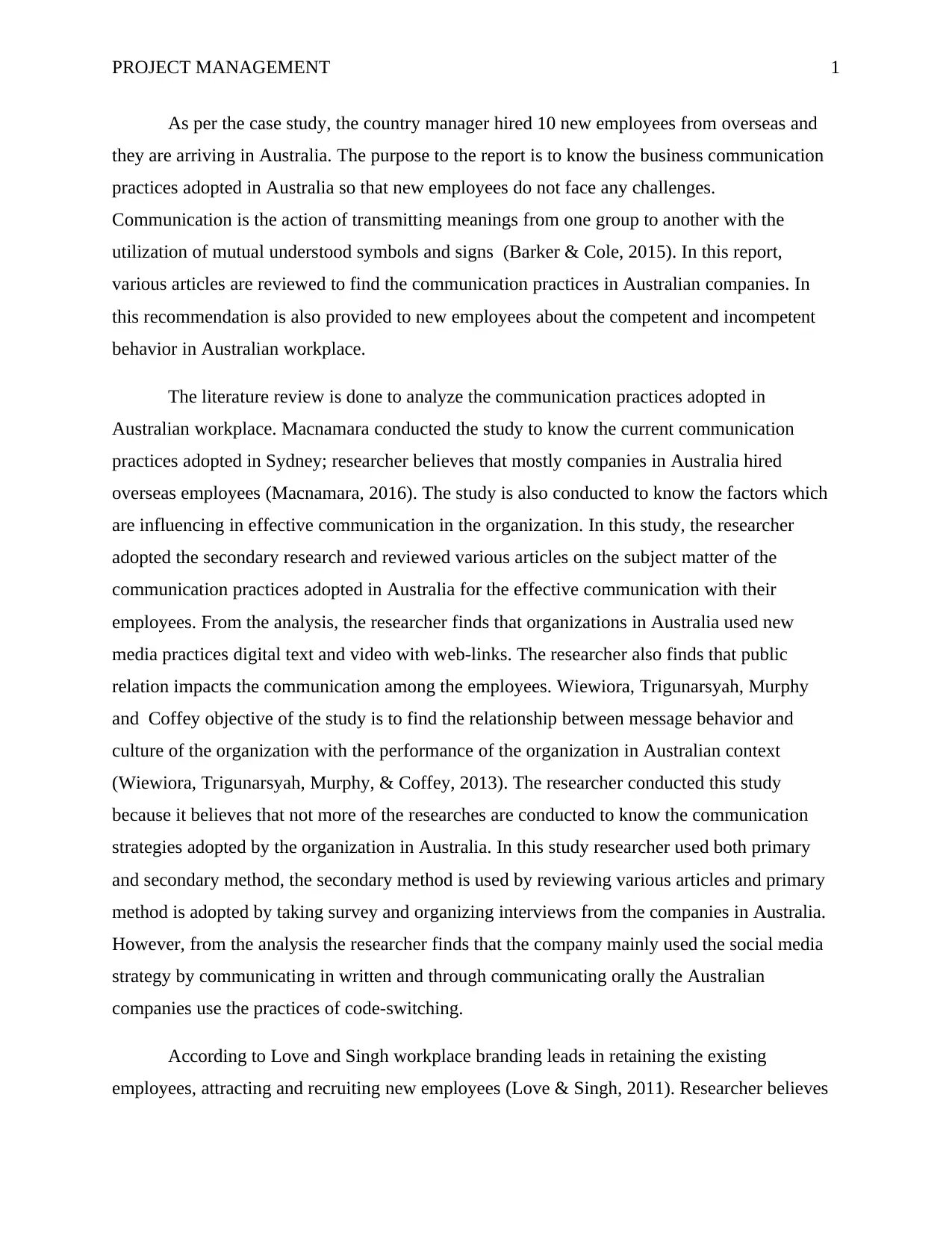
PROJECT MANAGEMENT 1
As per the case study, the country manager hired 10 new employees from overseas and
they are arriving in Australia. The purpose to the report is to know the business communication
practices adopted in Australia so that new employees do not face any challenges.
Communication is the action of transmitting meanings from one group to another with the
utilization of mutual understood symbols and signs (Barker & Cole, 2015). In this report,
various articles are reviewed to find the communication practices in Australian companies. In
this recommendation is also provided to new employees about the competent and incompetent
behavior in Australian workplace.
The literature review is done to analyze the communication practices adopted in
Australian workplace. Macnamara conducted the study to know the current communication
practices adopted in Sydney; researcher believes that mostly companies in Australia hired
overseas employees (Macnamara, 2016). The study is also conducted to know the factors which
are influencing in effective communication in the organization. In this study, the researcher
adopted the secondary research and reviewed various articles on the subject matter of the
communication practices adopted in Australia for the effective communication with their
employees. From the analysis, the researcher finds that organizations in Australia used new
media practices digital text and video with web-links. The researcher also finds that public
relation impacts the communication among the employees. Wiewiora, Trigunarsyah, Murphy
and Coffey objective of the study is to find the relationship between message behavior and
culture of the organization with the performance of the organization in Australian context
(Wiewiora, Trigunarsyah, Murphy, & Coffey, 2013). The researcher conducted this study
because it believes that not more of the researches are conducted to know the communication
strategies adopted by the organization in Australia. In this study researcher used both primary
and secondary method, the secondary method is used by reviewing various articles and primary
method is adopted by taking survey and organizing interviews from the companies in Australia.
However, from the analysis the researcher finds that the company mainly used the social media
strategy by communicating in written and through communicating orally the Australian
companies use the practices of code-switching.
According to Love and Singh workplace branding leads in retaining the existing
employees, attracting and recruiting new employees (Love & Singh, 2011). Researcher believes
As per the case study, the country manager hired 10 new employees from overseas and
they are arriving in Australia. The purpose to the report is to know the business communication
practices adopted in Australia so that new employees do not face any challenges.
Communication is the action of transmitting meanings from one group to another with the
utilization of mutual understood symbols and signs (Barker & Cole, 2015). In this report,
various articles are reviewed to find the communication practices in Australian companies. In
this recommendation is also provided to new employees about the competent and incompetent
behavior in Australian workplace.
The literature review is done to analyze the communication practices adopted in
Australian workplace. Macnamara conducted the study to know the current communication
practices adopted in Sydney; researcher believes that mostly companies in Australia hired
overseas employees (Macnamara, 2016). The study is also conducted to know the factors which
are influencing in effective communication in the organization. In this study, the researcher
adopted the secondary research and reviewed various articles on the subject matter of the
communication practices adopted in Australia for the effective communication with their
employees. From the analysis, the researcher finds that organizations in Australia used new
media practices digital text and video with web-links. The researcher also finds that public
relation impacts the communication among the employees. Wiewiora, Trigunarsyah, Murphy
and Coffey objective of the study is to find the relationship between message behavior and
culture of the organization with the performance of the organization in Australian context
(Wiewiora, Trigunarsyah, Murphy, & Coffey, 2013). The researcher conducted this study
because it believes that not more of the researches are conducted to know the communication
strategies adopted by the organization in Australia. In this study researcher used both primary
and secondary method, the secondary method is used by reviewing various articles and primary
method is adopted by taking survey and organizing interviews from the companies in Australia.
However, from the analysis the researcher finds that the company mainly used the social media
strategy by communicating in written and through communicating orally the Australian
companies use the practices of code-switching.
According to Love and Singh workplace branding leads in retaining the existing
employees, attracting and recruiting new employees (Love & Singh, 2011). Researcher believes
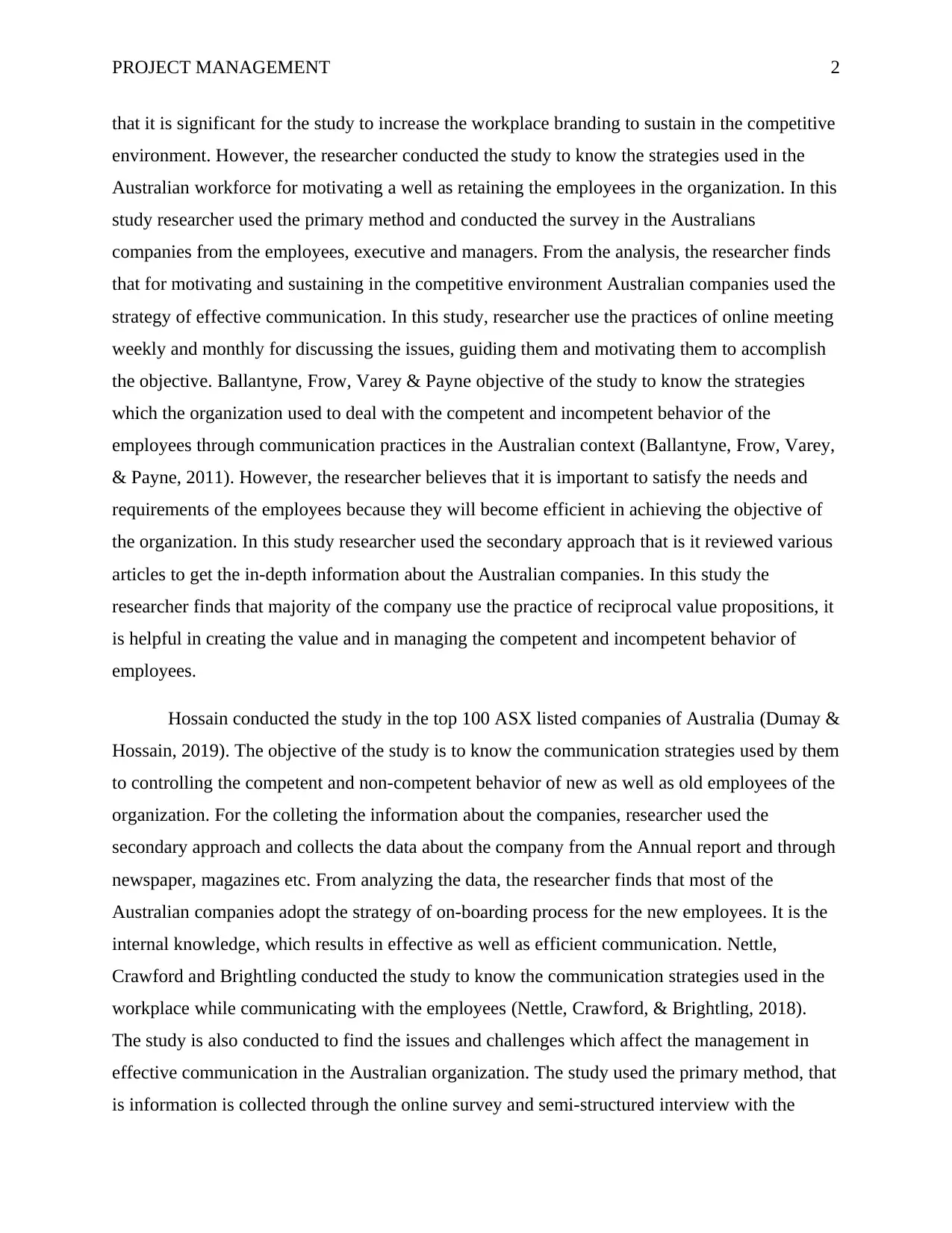
PROJECT MANAGEMENT 2
that it is significant for the study to increase the workplace branding to sustain in the competitive
environment. However, the researcher conducted the study to know the strategies used in the
Australian workforce for motivating a well as retaining the employees in the organization. In this
study researcher used the primary method and conducted the survey in the Australians
companies from the employees, executive and managers. From the analysis, the researcher finds
that for motivating and sustaining in the competitive environment Australian companies used the
strategy of effective communication. In this study, researcher use the practices of online meeting
weekly and monthly for discussing the issues, guiding them and motivating them to accomplish
the objective. Ballantyne, Frow, Varey & Payne objective of the study to know the strategies
which the organization used to deal with the competent and incompetent behavior of the
employees through communication practices in the Australian context (Ballantyne, Frow, Varey,
& Payne, 2011). However, the researcher believes that it is important to satisfy the needs and
requirements of the employees because they will become efficient in achieving the objective of
the organization. In this study researcher used the secondary approach that is it reviewed various
articles to get the in-depth information about the Australian companies. In this study the
researcher finds that majority of the company use the practice of reciprocal value propositions, it
is helpful in creating the value and in managing the competent and incompetent behavior of
employees.
Hossain conducted the study in the top 100 ASX listed companies of Australia (Dumay &
Hossain, 2019). The objective of the study is to know the communication strategies used by them
to controlling the competent and non-competent behavior of new as well as old employees of the
organization. For the colleting the information about the companies, researcher used the
secondary approach and collects the data about the company from the Annual report and through
newspaper, magazines etc. From analyzing the data, the researcher finds that most of the
Australian companies adopt the strategy of on-boarding process for the new employees. It is the
internal knowledge, which results in effective as well as efficient communication. Nettle,
Crawford and Brightling conducted the study to know the communication strategies used in the
workplace while communicating with the employees (Nettle, Crawford, & Brightling, 2018).
The study is also conducted to find the issues and challenges which affect the management in
effective communication in the Australian organization. The study used the primary method, that
is information is collected through the online survey and semi-structured interview with the
that it is significant for the study to increase the workplace branding to sustain in the competitive
environment. However, the researcher conducted the study to know the strategies used in the
Australian workforce for motivating a well as retaining the employees in the organization. In this
study researcher used the primary method and conducted the survey in the Australians
companies from the employees, executive and managers. From the analysis, the researcher finds
that for motivating and sustaining in the competitive environment Australian companies used the
strategy of effective communication. In this study, researcher use the practices of online meeting
weekly and monthly for discussing the issues, guiding them and motivating them to accomplish
the objective. Ballantyne, Frow, Varey & Payne objective of the study to know the strategies
which the organization used to deal with the competent and incompetent behavior of the
employees through communication practices in the Australian context (Ballantyne, Frow, Varey,
& Payne, 2011). However, the researcher believes that it is important to satisfy the needs and
requirements of the employees because they will become efficient in achieving the objective of
the organization. In this study researcher used the secondary approach that is it reviewed various
articles to get the in-depth information about the Australian companies. In this study the
researcher finds that majority of the company use the practice of reciprocal value propositions, it
is helpful in creating the value and in managing the competent and incompetent behavior of
employees.
Hossain conducted the study in the top 100 ASX listed companies of Australia (Dumay &
Hossain, 2019). The objective of the study is to know the communication strategies used by them
to controlling the competent and non-competent behavior of new as well as old employees of the
organization. For the colleting the information about the companies, researcher used the
secondary approach and collects the data about the company from the Annual report and through
newspaper, magazines etc. From analyzing the data, the researcher finds that most of the
Australian companies adopt the strategy of on-boarding process for the new employees. It is the
internal knowledge, which results in effective as well as efficient communication. Nettle,
Crawford and Brightling conducted the study to know the communication strategies used in the
workplace while communicating with the employees (Nettle, Crawford, & Brightling, 2018).
The study is also conducted to find the issues and challenges which affect the management in
effective communication in the Australian organization. The study used the primary method, that
is information is collected through the online survey and semi-structured interview with the
⊘ This is a preview!⊘
Do you want full access?
Subscribe today to unlock all pages.

Trusted by 1+ million students worldwide
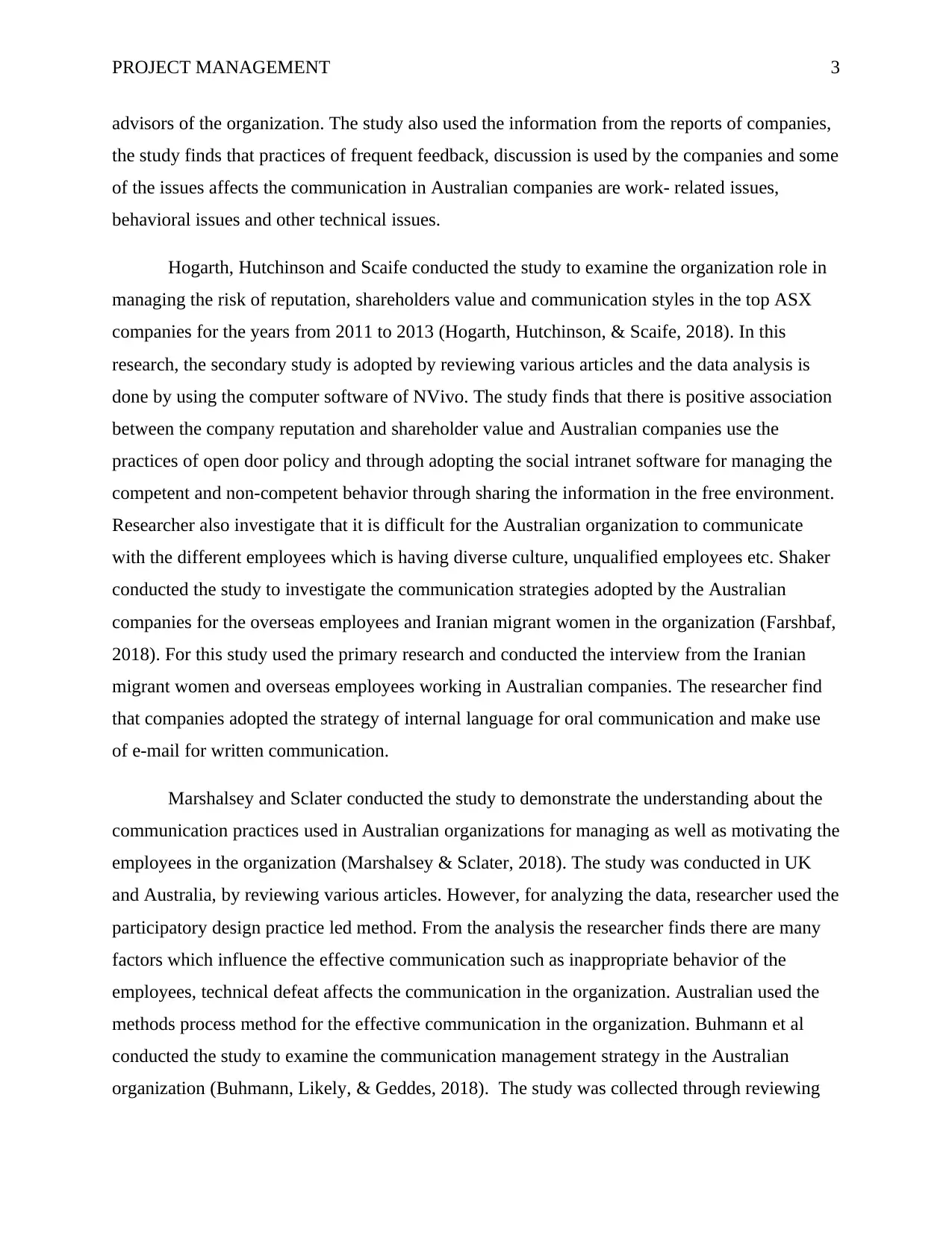
PROJECT MANAGEMENT 3
advisors of the organization. The study also used the information from the reports of companies,
the study finds that practices of frequent feedback, discussion is used by the companies and some
of the issues affects the communication in Australian companies are work- related issues,
behavioral issues and other technical issues.
Hogarth, Hutchinson and Scaife conducted the study to examine the organization role in
managing the risk of reputation, shareholders value and communication styles in the top ASX
companies for the years from 2011 to 2013 (Hogarth, Hutchinson, & Scaife, 2018). In this
research, the secondary study is adopted by reviewing various articles and the data analysis is
done by using the computer software of NVivo. The study finds that there is positive association
between the company reputation and shareholder value and Australian companies use the
practices of open door policy and through adopting the social intranet software for managing the
competent and non-competent behavior through sharing the information in the free environment.
Researcher also investigate that it is difficult for the Australian organization to communicate
with the different employees which is having diverse culture, unqualified employees etc. Shaker
conducted the study to investigate the communication strategies adopted by the Australian
companies for the overseas employees and Iranian migrant women in the organization (Farshbaf,
2018). For this study used the primary research and conducted the interview from the Iranian
migrant women and overseas employees working in Australian companies. The researcher find
that companies adopted the strategy of internal language for oral communication and make use
of e-mail for written communication.
Marshalsey and Sclater conducted the study to demonstrate the understanding about the
communication practices used in Australian organizations for managing as well as motivating the
employees in the organization (Marshalsey & Sclater, 2018). The study was conducted in UK
and Australia, by reviewing various articles. However, for analyzing the data, researcher used the
participatory design practice led method. From the analysis the researcher finds there are many
factors which influence the effective communication such as inappropriate behavior of the
employees, technical defeat affects the communication in the organization. Australian used the
methods process method for the effective communication in the organization. Buhmann et al
conducted the study to examine the communication management strategy in the Australian
organization (Buhmann, Likely, & Geddes, 2018). The study was collected through reviewing
advisors of the organization. The study also used the information from the reports of companies,
the study finds that practices of frequent feedback, discussion is used by the companies and some
of the issues affects the communication in Australian companies are work- related issues,
behavioral issues and other technical issues.
Hogarth, Hutchinson and Scaife conducted the study to examine the organization role in
managing the risk of reputation, shareholders value and communication styles in the top ASX
companies for the years from 2011 to 2013 (Hogarth, Hutchinson, & Scaife, 2018). In this
research, the secondary study is adopted by reviewing various articles and the data analysis is
done by using the computer software of NVivo. The study finds that there is positive association
between the company reputation and shareholder value and Australian companies use the
practices of open door policy and through adopting the social intranet software for managing the
competent and non-competent behavior through sharing the information in the free environment.
Researcher also investigate that it is difficult for the Australian organization to communicate
with the different employees which is having diverse culture, unqualified employees etc. Shaker
conducted the study to investigate the communication strategies adopted by the Australian
companies for the overseas employees and Iranian migrant women in the organization (Farshbaf,
2018). For this study used the primary research and conducted the interview from the Iranian
migrant women and overseas employees working in Australian companies. The researcher find
that companies adopted the strategy of internal language for oral communication and make use
of e-mail for written communication.
Marshalsey and Sclater conducted the study to demonstrate the understanding about the
communication practices used in Australian organizations for managing as well as motivating the
employees in the organization (Marshalsey & Sclater, 2018). The study was conducted in UK
and Australia, by reviewing various articles. However, for analyzing the data, researcher used the
participatory design practice led method. From the analysis the researcher finds there are many
factors which influence the effective communication such as inappropriate behavior of the
employees, technical defeat affects the communication in the organization. Australian used the
methods process method for the effective communication in the organization. Buhmann et al
conducted the study to examine the communication management strategy in the Australian
organization (Buhmann, Likely, & Geddes, 2018). The study was collected through reviewing
Paraphrase This Document
Need a fresh take? Get an instant paraphrase of this document with our AI Paraphraser

PROJECT MANAGEMENT 4
various articles about the communication strategies in the Australian organization. From the
analysis, researcher finds that organization adopt various written, oral communication for the
effective communication in the organization that are gamification tools, internal newsletter.
However for managing the competent and non- competent behavior the companies use the
strategy of communicating through the personal meeting, corporate mobile technologies and
discussion as well as taking feedback with the employees. For the effective measurement and
Evaluation Company use the strategy of addressing intervening variables, disseminating border
practices. Further, the recommendations are also provided to new employees for the competent
and incompetent behaviors in Australian organization.
From the above articles it finds that Australian organizations adopt various strategies for
managing the employee’s competent and incompetent behaviors through the communication
practices. However, from the reviewed it also demonstrate that through adopting various
practices Australian organization still find difficulty in communicating with the employees
having diverse behavior. It is also considered issue to communicate with the staff members
because of diverse culture (Dumay & Hossain, 2019). Therefore, it is important for the new
employees to behave effectively who all are arriving in Australia within six weeks.
According to Alteren and Tudoran employees should speak in quite-polished, well-
pronounced and speak in low-pitched voice while communicating with Australian employees
(Alteren & Tudoran, 2016). However, it is because of the culture followed in Australian
organization that employees should have the ability to speak in more refined manner. According
to Gallois and Giles the while communicating via computer or in written communication to
Australian employees, the new employees should communicate in speed, use the shorten words
such as “arvo” for afternoon etc. because Australian organization adopt the strategy of faster
communication (Gallois & Giles, 2015).
According to Dolan et al holding eye contact for longer duration, while communicating
orally with an Australian employee is considered as incompetency behavior because holding it
for prolonged time make Australians feel uncomfortable (Dolan, et al., 2019). According to
Murray et al if the employee is not well-qualified or have knowledge about what is to
communicate to provide complete information while communicating in written or through
computer-mediated is consider as incompetency behavior (Murray, et al., 2015). It is because
various articles about the communication strategies in the Australian organization. From the
analysis, researcher finds that organization adopt various written, oral communication for the
effective communication in the organization that are gamification tools, internal newsletter.
However for managing the competent and non- competent behavior the companies use the
strategy of communicating through the personal meeting, corporate mobile technologies and
discussion as well as taking feedback with the employees. For the effective measurement and
Evaluation Company use the strategy of addressing intervening variables, disseminating border
practices. Further, the recommendations are also provided to new employees for the competent
and incompetent behaviors in Australian organization.
From the above articles it finds that Australian organizations adopt various strategies for
managing the employee’s competent and incompetent behaviors through the communication
practices. However, from the reviewed it also demonstrate that through adopting various
practices Australian organization still find difficulty in communicating with the employees
having diverse behavior. It is also considered issue to communicate with the staff members
because of diverse culture (Dumay & Hossain, 2019). Therefore, it is important for the new
employees to behave effectively who all are arriving in Australia within six weeks.
According to Alteren and Tudoran employees should speak in quite-polished, well-
pronounced and speak in low-pitched voice while communicating with Australian employees
(Alteren & Tudoran, 2016). However, it is because of the culture followed in Australian
organization that employees should have the ability to speak in more refined manner. According
to Gallois and Giles the while communicating via computer or in written communication to
Australian employees, the new employees should communicate in speed, use the shorten words
such as “arvo” for afternoon etc. because Australian organization adopt the strategy of faster
communication (Gallois & Giles, 2015).
According to Dolan et al holding eye contact for longer duration, while communicating
orally with an Australian employee is considered as incompetency behavior because holding it
for prolonged time make Australians feel uncomfortable (Dolan, et al., 2019). According to
Murray et al if the employee is not well-qualified or have knowledge about what is to
communicate to provide complete information while communicating in written or through
computer-mediated is consider as incompetency behavior (Murray, et al., 2015). It is because

PROJECT MANAGEMENT 5
Australian organization follows the culture of providing correct and exact information within
workplace.
From the above it is conclude that project management considered as developing plans,
executing them etc. From the above it is also conclude that Australian organization finds
difficulty in communicating with the diverse culture employees. However, for this new employee
who is hire to work in Australia should follow the communication culture of Australia that is
speaks in more refine ways and slowly. The employee should also not follow incompetency
behaviors which include communicating without complete knowledge.
References
Australian organization follows the culture of providing correct and exact information within
workplace.
From the above it is conclude that project management considered as developing plans,
executing them etc. From the above it is also conclude that Australian organization finds
difficulty in communicating with the diverse culture employees. However, for this new employee
who is hire to work in Australia should follow the communication culture of Australia that is
speaks in more refine ways and slowly. The employee should also not follow incompetency
behaviors which include communicating without complete knowledge.
References
⊘ This is a preview!⊘
Do you want full access?
Subscribe today to unlock all pages.

Trusted by 1+ million students worldwide

PROJECT MANAGEMENT 6
Alteren, G., & Tudoran, A. A. (2016). Enhancing export performance: Betting on customer
orientation, behavioral commitment, and communication. International Business Review ,
25 (1), 370-381.
Ballantyne, D., Frow, P., Varey, R. J., & Payne, A. (2011). Value propositions as communication
practice: Taking a wider view. Industrial Marketing Management , 40 (2), 202-210.
Barker, S., & Cole, R. (2015). Brilliant Project Management. London: Pearson.
Buhmann, A., Likely, F., & Geddes, D. (2018). Communication evaluation and measurement:
connecting research to practice. Journal of Communication Management , 22 (1), 113-
119.
Dolan, H., Alden, D. L., Friend, J. M., Lee, P. Y., Lee, Y. K., Ng, C. J., et al. (2019). Culture,
Self, and Medical Decision Making in Australia and China: A Structural Model Analysis.
MDM Policy & Practice , 4 (2).
Dumay, J., & Hossain, M. A. (2019). Sustainability risk disclosure practices of listed companies
in Australia. Australian Accounting Review , 29 (2), 343-359.
Farshbaf, S. S. (2018). A Study of Transnational Communication Among Iranian Migrant
Women in Australia. Journal of Immigrant & Refugee Studies , 16 (3), 293-312.
Gallois, C., & Giles, H. (2015). Communication accommodation theory. The international
encyclopedia of language and social interaction , 1-18.
Hogarth, K., Hutchinson, M., & Scaife, W. (2018). Corporate philanthropy, reputation risk
management and shareholder value: A study of Australian corporate giving. Journal of
Business Ethics , 151 (2), 375-390.
Love, L. F., & Singh, P. (2011). Workplace branding: Leveraging human resources management
practices for competitive advantage through “Best Employer” surveys. Journal of
Business and Psychology , 26 (2).
Macnamara, J. (2016). The continuing convergence of journalism and PR: New insights for
ethical practice from a three-country study of senior practitioners. Journalism & Mass
Communication Quarterly , 93 (1), 118-141.
Marshalsey, L., & Sclater, M. (2018). Critical perspectives of technology-enhanced learning in
relation to specialist Communication Design studio education within the UK and
Australia. Research in Comparative and International Education , 13 (1), 92-116.
Murray, A., Hall, A. M., Williams, G. C., McDonough, S. M., Ntoumanis, N., Taylor, I. M., et
al. (2015). Effect of a self-determination theory–based communication skills training
program on physiotherapists' psychological support for their patients with chronic low
Alteren, G., & Tudoran, A. A. (2016). Enhancing export performance: Betting on customer
orientation, behavioral commitment, and communication. International Business Review ,
25 (1), 370-381.
Ballantyne, D., Frow, P., Varey, R. J., & Payne, A. (2011). Value propositions as communication
practice: Taking a wider view. Industrial Marketing Management , 40 (2), 202-210.
Barker, S., & Cole, R. (2015). Brilliant Project Management. London: Pearson.
Buhmann, A., Likely, F., & Geddes, D. (2018). Communication evaluation and measurement:
connecting research to practice. Journal of Communication Management , 22 (1), 113-
119.
Dolan, H., Alden, D. L., Friend, J. M., Lee, P. Y., Lee, Y. K., Ng, C. J., et al. (2019). Culture,
Self, and Medical Decision Making in Australia and China: A Structural Model Analysis.
MDM Policy & Practice , 4 (2).
Dumay, J., & Hossain, M. A. (2019). Sustainability risk disclosure practices of listed companies
in Australia. Australian Accounting Review , 29 (2), 343-359.
Farshbaf, S. S. (2018). A Study of Transnational Communication Among Iranian Migrant
Women in Australia. Journal of Immigrant & Refugee Studies , 16 (3), 293-312.
Gallois, C., & Giles, H. (2015). Communication accommodation theory. The international
encyclopedia of language and social interaction , 1-18.
Hogarth, K., Hutchinson, M., & Scaife, W. (2018). Corporate philanthropy, reputation risk
management and shareholder value: A study of Australian corporate giving. Journal of
Business Ethics , 151 (2), 375-390.
Love, L. F., & Singh, P. (2011). Workplace branding: Leveraging human resources management
practices for competitive advantage through “Best Employer” surveys. Journal of
Business and Psychology , 26 (2).
Macnamara, J. (2016). The continuing convergence of journalism and PR: New insights for
ethical practice from a three-country study of senior practitioners. Journalism & Mass
Communication Quarterly , 93 (1), 118-141.
Marshalsey, L., & Sclater, M. (2018). Critical perspectives of technology-enhanced learning in
relation to specialist Communication Design studio education within the UK and
Australia. Research in Comparative and International Education , 13 (1), 92-116.
Murray, A., Hall, A. M., Williams, G. C., McDonough, S. M., Ntoumanis, N., Taylor, I. M., et
al. (2015). Effect of a self-determination theory–based communication skills training
program on physiotherapists' psychological support for their patients with chronic low
Paraphrase This Document
Need a fresh take? Get an instant paraphrase of this document with our AI Paraphraser
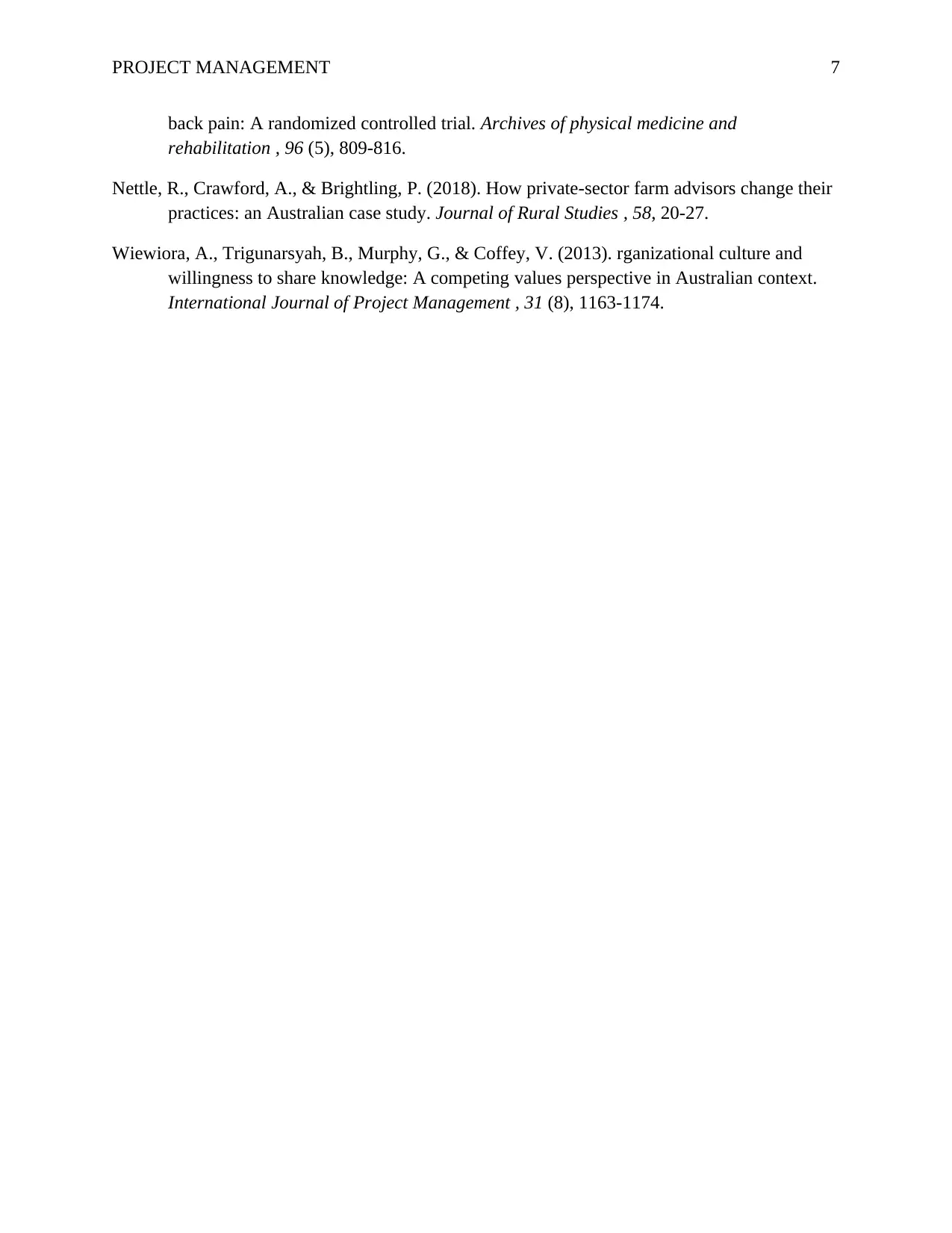
PROJECT MANAGEMENT 7
back pain: A randomized controlled trial. Archives of physical medicine and
rehabilitation , 96 (5), 809-816.
Nettle, R., Crawford, A., & Brightling, P. (2018). How private-sector farm advisors change their
practices: an Australian case study. Journal of Rural Studies , 58, 20-27.
Wiewiora, A., Trigunarsyah, B., Murphy, G., & Coffey, V. (2013). rganizational culture and
willingness to share knowledge: A competing values perspective in Australian context.
International Journal of Project Management , 31 (8), 1163-1174.
back pain: A randomized controlled trial. Archives of physical medicine and
rehabilitation , 96 (5), 809-816.
Nettle, R., Crawford, A., & Brightling, P. (2018). How private-sector farm advisors change their
practices: an Australian case study. Journal of Rural Studies , 58, 20-27.
Wiewiora, A., Trigunarsyah, B., Murphy, G., & Coffey, V. (2013). rganizational culture and
willingness to share knowledge: A competing values perspective in Australian context.
International Journal of Project Management , 31 (8), 1163-1174.
1 out of 8
Related Documents
Your All-in-One AI-Powered Toolkit for Academic Success.
+13062052269
info@desklib.com
Available 24*7 on WhatsApp / Email
![[object Object]](/_next/static/media/star-bottom.7253800d.svg)
Unlock your academic potential
Copyright © 2020–2025 A2Z Services. All Rights Reserved. Developed and managed by ZUCOL.





